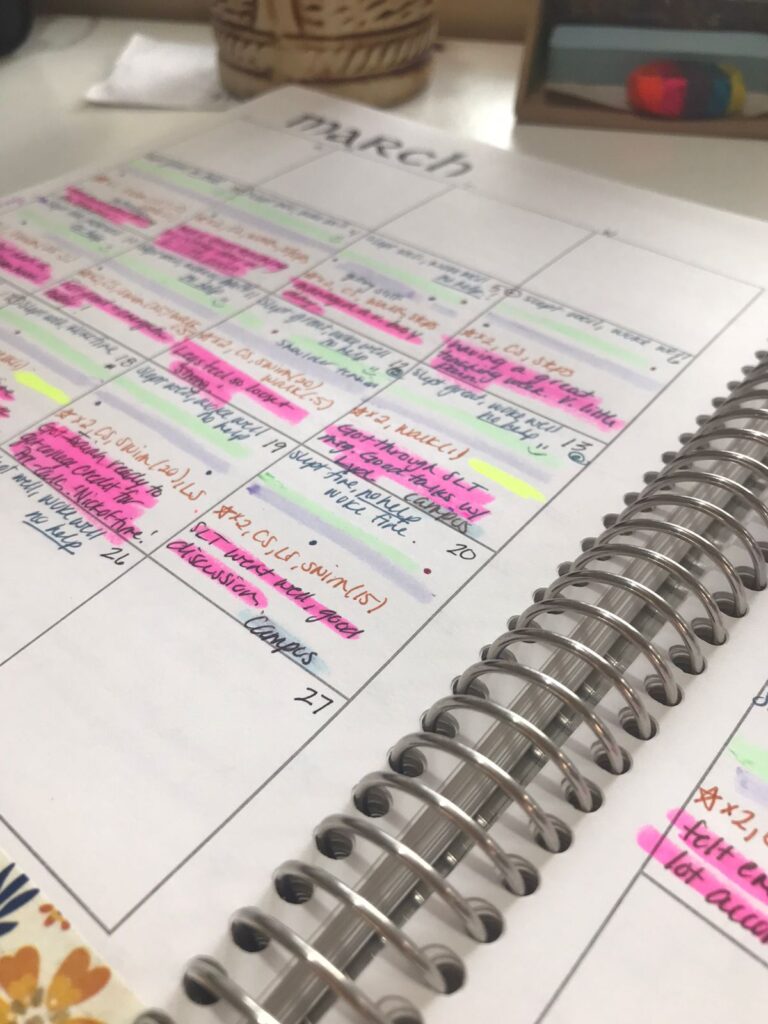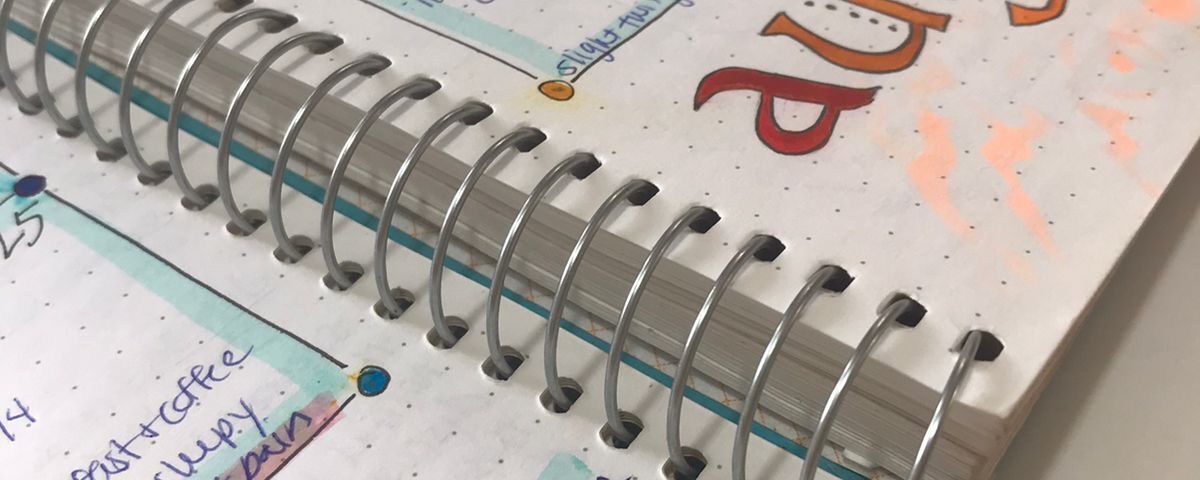
Awareness and Relationship Issues
July 29, 2024
Range of Motion
October 27, 2024In my last blog entry, I introduced the idea of learning to change my relationship with my pain. The first baby step came when I learned to shift my attention away from the painful sensations in my body. Like a butterfly, my mind could flit away from my pain, but also like a butterfly, it never stayed anywhere very long, except for home base: my pain.
More than just pulling my awareness away from my pain, I needed a place to put my pain. The calendar I used for my pain journal provided the perfect little box each day. Honestly, I have forgotten where I got this idea, but it makes a lot of practical sense. A pain journal provided a way to think about my pain…instead of just feeling it and being overwhelmed by it. I said things like, “I have migraines all the time.” But…Do I really? Keeping a pain journal helped me learn to be more objective and avoid using inaccurate words that psychologically intensified my pain. At first, my pain journal was not so organized. There seemed to be too many things to mark or code for: low back pain, headaches, migraines, and knee pain. I kept track of what medicines I took and at what time of day, when I had physical therapy, and how much I exercised. I rated my pain levels, noted how well I slept. Did I have more headaches when I didn’t sleep well? Yes, often. Did I feel extra pain during a certain time of the month? Most definitely. I started to become a detective. I was getting curious! Instead of walking through the day in a cloud of overwhelming pain, I felt like I was getting more organized about it. Through the pain journal, I felt like I was exerting some small amount of personal power over my pain. I at least had the ability to look at it and quantify it. I could accurately call it out and look at it once it was on paper.
Speaking of quantifying pain: here is a helpful pain scale that I use:
0 = pain free
2 = annoying, bothers you throughout the day, but can be tolerated
4 = challenging, it hurts, but you can be distracted for 30-40 minutes
6 = hard to concentrate, but you can do normal activities with effort
8 = breathing heavy, you find it hard to speak
10 = so bad you go unconscious
Having these guidelines, which I got from YouTube videos from Total Therapy Solutions,[i] helped me have a bit more control and not give emotionally driven designations about my pain levels. Though I’ve often felt like my pain is more than I can bear, I’ve yet to go unconscious. (Thank goodness!) My bad migraines would occasionally be at level 8, but I wasn’t having “migraines all the time,” as I might have expressed in the past. I also had a better way to note difference in pain. My headache might be a 4 in the morning when I wake up, but it downgrades to a 2 by the time I’m ready for homeschool with the kids. Learning to view the changes without making judgements is part of somatic tracking (a concept covered in The Way Out by Alan Gordon). Very interestingly, we need to let go of long-term goals of reducing pain. And, at this early point in the process, we need to begin to notice and celebrate change. Truly traumatic, feeling utterly stuck in pain leads to hopelessness. When I can notice small changes, I am able to detach my brain from strong feelings of hopeless entrapment.
In my first month of pain journalling, August of 2021, I had 5 headache-free days. Not a very encouraging number, but I would faithfully mark those days with celebratory colors. I’ve kept a pain journal for 3 years now. It only takes about 2-3 minutes each day, now that I have a system in place. As of 2024, I had 21 headache-free days in April! My migraines have reduced in intensity, so much so that they can barely be called migraines. They are much more like normal headaches that irritate (level 2), but don’t send me to bed dreaming of oblivion (level 8). That is a major victory in my book! More than that, I don’t feel the fear surrounding headaches as I used to. This will be covered when I write about the pain/fear cycle, but a heads-up is my encouragement to read The Way Out. I listened to the audio version of this book multiple times. Combined with daily clinical somatics,[ii] the key to reducing my headaches was breaking the cycle of fear. Because of daily somatics, I rarely have back pain now. I carried way too much tension in my back and shoulders, and I needed to learn how to release that. It is possible! My pain journal offers that proof!
With less pain to record in my pain journal, I have more space for daily victories. I shamelessly celebrate small victories. Some of my recent victories:
“Felt stressed but chose to relax!”
“Got to do a bit of artwork.”
“Woke up with headache, but stayed calm.”
“Learned something new about protective reactions.”
“Did somatics before taking headache medicine.”
“Enjoyed socializing with friends.”
These victories may seem small…and, actually, many significant and notable things in our work and family life are happening alongside these personal victories. Somehow, I’m not quite as thrilled about the big things because I know how easily these small things might not have happened had I not been able to change my relationship with my pain. However, if you meet me in person, I’ll tell you about the big significant things God is doing in our lives, not necessarily these small victories. That is because of something very good: now that I’m not in so much pain, I don’t need to talk about myself and my pain as much. There are other things on the tip of my tongue and I’m discovering who I am now that I’m detaching myself from such an unhealthy relationship with my pain.
I’ll close this blog entry with two last reasons my pain journal has helped me. First, as a result of my detective work, I started to notice patterns. As I noticed patterns in my pain, I got the courage to be experimental and hope for change. For example, if I have a headache after every time I drive the car, maybe I need new low-back cushion in the car, or maybe I need to spend time on the mat doing somatics when I get home from a car ride. By evening, if I get super crabby due to pain, maybe I need to do dinner prep earlier in the day.
Secondly, in 2023 with startling clarity, I saw myself getting more and more dependent on over-the-counter pain medicine. Self-medicating can put anyone (me definitely included) on a deceptive path toward addiction. As soon as I felt the beginning twinge of a headache, I would immediately take some medicine because of the fear that the headache would get worse if I didn’t do something about it right away. I’d even faithfully take anticipatory medicine: “I always get headaches in the car, so I’ll take medicine beforehand to prevent it.” In my head, I knew the medicine was not even working, but I couldn’t stop taking it. Though I couldn’t stop, I very faithfully recorded every time I took it. I felt the need to be accountable even if I couldn’t stop at that point.
Noticing patterns helped me be experimental in changing my dependence on medicines. I gained courage to postpone taking headache medicine until after I did my somatics, or my relaxion techniques, or took a break from the computer. If my head still hurt, I felt better about taking medicine. I had built into my life other resources to depend on that were more likely to reduce my headaches. For my knee, I gained help from my honest physical therapist (see this article). She helped me try different medications, and I kept track of my responses to the medicines. I even made notes in capital letters in my journal to tell myself that this or that medication DID NOT WORK. Together, we found a safe medication that reduced inflammation in my knee! That is a victory—not only a victory over a dependence on something that was not helpful, but also a breakthrough in pain that allowed me to start developing healthier walking patterns. My prayer is that as my leg gets stronger, I’ll be able to reduce this medication in the coming months. You can bet it will be recorded in my pain journal with celebratory colors! Maybe I’ll add stickers and smiley faces, too!)
Lastly, as mentioned at the top of this article, I needed a place to put my pain. I felt frustrated with my need to continuously dump my pain reports on my husband, parents, or friends. I mean — to me my pain is fascinating—but I have enough self-awareness to understand that it might not be so for others…all the time…every day. How much can they really take before they start experiencing compassion fatigue? Now, my pain journal feels like a sacred holding space for my pain. As I record how each day has gone, I have a strong sense of offering my pain up to God, a mini-daily version of what Jesus did in the Garden of Gethsemane: “Father, if you are willing, remove this cup from me. Nevertheless, not my will, but yours, be done” (Luke 22:42, ESV). God has not grown weary of my daily reports and offers me grace for each day: the ones that go well and the ones where progress seems to be going backward. Just like the woman who suffered for 12 years got to tell Jesus the “whole truth” about her suffering (Matthew 5:23), my pain journal has given me a place to do just that—tell Him everything. He celebrates the small victories with me and helps me process the terrible migraines or knee pain that make me want to give up. He sees each experience and walks through it with me. We are still walking together each day, and the pain reports are slowly changing.
[i] Total Therapy Solutions: https://youtu.be/mkjp3qNKy1o?si=K_NKDDe7fquUXpnN/.
[ii] Inspire Somatics: https://inspiresomatics.com/.
Recommended Repeated Reading: The Way Out: A Revolutionary Scientifically Proven Approach to Healing Chronic Pain by Alan Gordon, 2021, Avery.




4 Comments
Sarah, I have never actually thought of a pain journal, but it makes so much sense as I read your experience with one. A place to put the pain and celebrate little victories. Thank you for sharing your journey of chronic pain to so many aspects of healing. Blessings of health and hope to you my Friend!
Thanks, Valerie! Yes, I can’t believe I’ve never talked to you about my pain journal as it has been my most consistent journal for so long. Of course, cute washi tape makes it even better! :0)
“God has not grown weary of my daily reports and offers me grace for each day” Oh, yes, isn’t it a comfort to think that God will not get compassion fatigue? It surely comforts me
Yes, Marie. Thanks for noticing this important idea. This always stuns me about God’s lovingkindness. He does not grow weary.